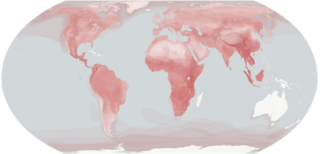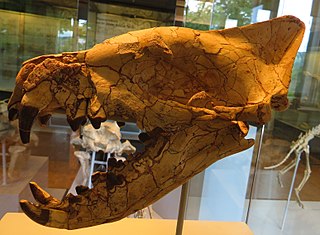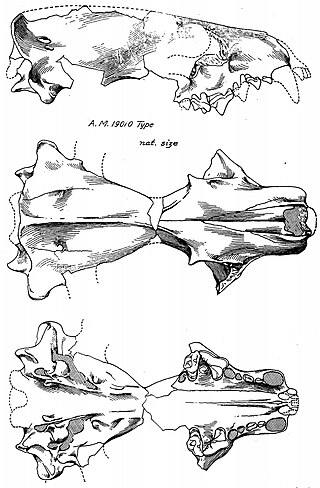
Carnivora is an order of placental mammals that have specialized in primarily eating flesh, whose members are formally referred to as carnivorans. The order Carnivora is the fifth largest order of mammals, comprising at least 279 species.

Caniformia is a suborder within the order Carnivora consisting of "dog-like" carnivorans. They include dogs, bears, raccoons, and mustelids. The Pinnipedia are also assigned to this group. The center of diversification for the Caniformia is North America and northern Eurasia. Caniformia stands in contrast to the other suborder of Carnivora, the Feliformia, the center of diversification of which was in Africa and southern Asia.

Hyaenodontidae is an extinct family of placental mammals from extinct superfamily Hyaenodontoidea within extinct order Hyaenodonta. Hyaenodontids arose during the early Eocene and persisted well into the early Miocene. Fossils of this group have been found in Asia, North America and Europe.

Hyaenodon ("hyena-tooth") is an extinct genus of carnivorous placental mammals from extinct tribe Hyaenodontini within extinct subfamily Hyaenodontinae, that lived in Eurasia and North America from the middle Eocene, throughout the Oligocene, to the early Miocene.

Aelurodon is an extinct canid genus of the subfamily Borophaginae which lived from the Barstovian land mammal age of the middle Miocene to the late Miocene epoch. Aelurodon existed for approximately 10.7 million years.

Ailuropodinae is a subfamily of Ursidae that contains only one extant species, the giant panda of China. The fossil record of this group has shown that various species of pandas were more widespread across the Holarctic, with species found in places such as Europe, much of Asia and even North America. The earliest pandas were not unlike other modern bear species in that they had an omnivorous diet but by around 2.4 million years ago, pandas have evolved to be more herbivorous.

Phlaocyon is an extinct genus of the Borophaginae subfamily of canids native to North America. It lives from the Early Oligocene to the Early Miocene epoch 33.3–16.3 Mya, existing for approximately 17.3 million years. It is closely related to Cynarctoides.

Enaliarctos is an extinct genus of pinnipedimorph, and may represent the ancestor to all pinnipeds. Prior to the discovery of Puijila, the five species in the genus Enaliarctos represented the oldest known pinnipedimorph fossils, having been recovered from late Oligocene and early Miocene strata of California and Oregon.
Parictis is an extinct arctoid belonging to the family Subparictidae.

Ursoidea is a superfamily of arctoid carnivoran mammals that includes the families Subparictidae, Amphicynodontidae, and Ursidae which the last family includes the extant lineages of bears as well the extinct Hemicyoninae and Ursavinae. The interrelationships of ursoids has had slight arrangements. In the past it was thought the extinct Amphicyonidae were stem-bears based on morphological analysis of the ear region, though the most recent publications on early amphicyonids suggests they were basal caniforms. The amphicynodontids are sometimes classified as either a subfamily of bears, a paraphyletic assemblage of early bears, or even stem-pinnipeds. The subparictids were previously classified as amphicynodontine/ids. The hemicyonines have been occasionally reclassified as a separate family.

Kolponomos is an extinct genus of carnivoran mammal that existed in the Late Arikareean North American Land Mammal Age, early Miocene epoch, about 20 million years ago. It was likely a marine mammal. The genus was erected in 1960 by Ruben A. Stirton, a paleontologist at the University of California Museum of Paleontology, Berkeley, for the species K. clallamensis, on the basis of a partial skull and jaw found on the Olympic Peninsula. At the time, Stirton questionably assigned it to Procyonidae, its systematic position remained problematic until the discovery of more fossils including a nearly complete cranium from the original locality of K. clallamensis which helped identify it as part of the group from which pinnipeds evolved.
Paramiacis is an extinct genus of placental mammals from clade Carnivoraformes, that lived in Europe from the middle to late Eocene. Species P. exilis and P. teilhardi were long believed to be the same species, with differences that were only represented as an example of sexual dimorphism.

Arctoidea is a clade of mostly carnivorous mammals which include the extinct Hemicyonidae (dog-bears), and the extant Musteloidea, Pinnipedia, and Ursidae (bears), found in all continents from the Eocene, 46 million years ago, to the present. The oldest group of the clade is the bears, as their CMAH gene is still intact. The gene became non-functional in the common ancestor of the Mustelida. Arctoids are caniforms, along with dogs (canids) and extinct bear dogs (Amphicyonidae). The earliest caniforms were superficially similar to martens, which are tree-dwelling mustelids. Together with feliforms, caniforms compose the order Carnivora; sometimes Arctoidea can be considered a separate suborder from Caniformia and a sister taxon to Feliformia.

Hemicyoninae is an extinct subfamily of Ursidae, often called dog bears. They were bear-like carnivorans living in Europe, North America, Africa and Asia during the Oligocene through Miocene epochs 33.9–5.3 Ma, existing for approximately 28.6 million years. They are sometimes classified as a separate family.

Palaeogale is an extinct genus of carnivorous mammal known from the Late Eocene, Oligocene, and Early Miocene of North America, Europe, and Eastern Asia. A small carnivore often associated with the mustelids, Palaeogale might have been similar to living genets, civets, and linsangs.

Otarioidea is a superfamily of pinnipeds that includes the families Odobenidae, Otariidae and their stem-relatives. In the past when the pinnipeds were considered to be a diphyletic group of marine mammals, a few points of cranial and dental morphology suggested that the otarioids originated from a line of bears. One extinct family, Enaliarctidae, was postulated to be otarioids that were a transitional clade between Hemicyoninae and Otariidae. Recent comprehensive studies have, however, since the 1990s found pinnipeds to be a monophyletic clade of aquatic arctoids. There are a few authorities that place desmatophocids and odobenids as sister taxa to Phocidae in the clade Phocomorpha based on a few minor physiological features.

Hyaenodontinae is an extinct subfamily of predatory placental mammals from extinct family Hyaenodontidae. Fossil remains of these mammals are known from early Eocene to early Miocene deposits in Europe, Asia and North America.
Subparictidae is an extinct family of early Paleogene arctoid carnivorans endemic to North America that closely related to bears. They were small, raccoon-like mammals that lived from the Eocene to the early Miocene. This family includes a handful of genera such as Subparictis, Parictis, Nothocyon, and Eoarctos.

Amphicticeps is an extinct genus of small, weasel-like carnivoran mammal. It lived in Mongolia during the Oligocene. The genus was erected in 1924 for the species A. shackelfordi on the basis of a well-preserved skull. Historically, the systematic position of this genus has been problematic until more specimens were described decades later.



















